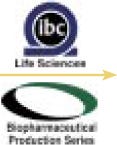BioProcess International Analytical and Quality Summit
April 1, 2008

This event offers key strategic insights from industry leaders regarding assay qualification and validation optimization, improvement of the pace and quality of analytical results, and improvement of product quality through increased process understanding. It brings together three conference programs including The 4th Annual Analytical Method Validation, the 2nd Annual Biophysical Analysis for Bioprocessing, and IBC’s 5th Annual Process Quality Forum on Process Characterization and Control.
Analytical Method Validation
This event gives assay development and validation scientists a broad view of how qualification and validation activities are performed across the industry. Learn about timing and resource allocation at each step, receive updates on key regulatory and standards initiatives, and learn how to optimize your method transfers.
Wyeth demonstrates a set of novel timing strategies to help accelerate analytical development and validation for a protein therapeutic.
Medarex explains how to overcome the challenges in validating peptide map assays during early and late phases of biologics development.
Eli Lilly and Company presents a case study of a bioassay validation protocol containing parameters and acceptance criteria derived from both bioassay and statistical perspectives — and the subsequent method transfer to a global site.
Analytical Keynotes
“Interdependence of Product Characterization, Analytical Method Validation, and Comparability Assessment” by Chulani Karunatilake, PhD, director of analytical sciences, Amgen, Inc.
“Applying Quality by Design Principles to Assay Development and Validation” by Dieter Schmalzing, PhD, associate director, Genentech, Inc.
Biophysical Analysis for Bioprocessing
This event provides experienced analytical scientists a set of important case studies showing how advanced analytical methods (including dynamic light scattering, field flow fractionation, static light scattering, and analytical ultracentrifugation) are being used alone and together to characterize proteins and achieve greater product stability.
Rensselaer Polytechnic Institute outlines a computational approach that enables the engineering of proteins with enhanced stability by rational redesign of protein surfaces.
Pfizer describes a valuable tool for formulation development that can identify potential markers for physical and chemical instabilities in biologics using sequence and structure information.
Abbott shows how to improve analytical results by demonstrating how capillary electrophoresis and analytical ultracentrifugation are used to strengthen traditional polyacrylamide gel electrophoresis and size-exclusion chromatography analysis of monoclonal antibodies.
Biophysical Keynotes
“New Methods for Characterization of Protein Aggregation” by Tudor Arvinte, PhD, professor in the department of pharmaceutics and biopharmaceutics at the School of Pharmacy, University of Geneva, Switzerland
“The Application of Novel Biophysical Methods for Drug Development” by Jun Liu, PhD, senior scientist, Genentech, Inc.
Process Characterization and Control
This process quality forum builds on four years of process analytical technology (PAT) and quality-by-design (QbD) events to offer you a conference full of case studies demonstrating how process understanding is used to improve product quality across unit operations.
Genentech and Biogen Idec share perspectives from their experiences in integrating QbD-based programs into their organizations.
Regeneron presents a case study of how modifications of clarification processes impacts the outcome of purification processes.
MIT describes the results of a comparative study between samples from an automated sampling system and manually acquired samples; demonstrating how automation in cell culture process development can affect product quality.
Process Control Keynotes
“Quality by Design in Biotechnology: Why and How?” by Wassim Nashabeh, PhD, director of CMC regulatory affairs, Genentech, Inc.
“Application of QbD for Development and Manufacturing of a BioPharamaceutical” by Rohin Mhatre, PhD, director of bioprocess development, Biogen Idec, Inc.
You May Also Like





